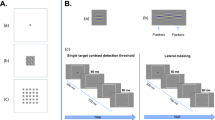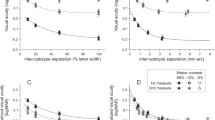Abstract
Background
This study compares the influence of two different types of magnification (magnifier versus large print) on crowded near vision task performance.
Methods
Fifty-eight visually impaired children aged 4–8 years participated. Participants were divided in two groups, matched on age and near visual acuity (NVA): [1] the magnifier group (4–6 year olds [n = 13] and 7–8 year olds [n = 19]), and [2] the large print group (4–6 year olds [n = 12] and 7–8 year olds [n = 14]). At baseline, single and crowded Landolt C acuity were measured at 40 cm without magnification. Crowded near vision was measured again with magnification. A 90 mm diameter dome magnifier was chosen to avoid measuring the confounding effect of navigational skills. The magnifier provided 1.7× magnification and the large print provided 1.8× magnification. Performance measures: [1] NVA without magnification at 40 cm, [2] near vision with magnification, and [3] response time. Working distance was monitored.
Results
There was no difference in performance between the two types of magnification for the 4–6 year olds and the 7–8 year olds (p’s = .291 and .246, respectively). Average NVA in the 4–6 year old group was 0.95 logMAR without and 0.42 logMAR with magnification (p < .001). Average NVA in the 7–8 year was 0.71 logMAR without and 0.01 logMAR with magnification (p < .001). Stronger crowding effects predicted larger improvements of near vision with magnification (p = .021).
Conclusions
A magnifier is equally effective as large print in improving the performance of young children with a range of visual acuities on a crowded near vision task. Visually impaired children with stronger crowding effects showed larger improvements when working with magnification.




Similar content being viewed by others
References
Cox RF, Reimer AM, Verezen CA, Smitsman AW, Vervloed MP, Boonstra FN (2009) Young children’s use of a visual aid: an experimental study of the effectiveness of training. Dev Med Child Neurol 51:460–467
Schurink J, Cox RF, Cillessen AH, van Rens GH, Boonstra FN (2011) Low vision aids for visually impaired children: a perception-action perspective. Res Dev Disabil 32:871–882
Cox RFA, Reimer AM, Smitsman AW, Verezen CA, Vervloed MPJ, Boonstra FN (2007) Low-vision aids for young visually impaired children: learning to use a magnifier. In: Cummins-Sebree S, Riley M, Shockley K (eds) Studies in action and perception IX. Erlbaum, Hillsdale, pp 143–146
Reimer AM, Cox RF, Nijhuis-Van der Sanden MW, Boonstra NF (2011) Improvement of fine motor skills in children with a visual impairment: an explorative study. Res Dev Disabil 32:1924–1933
Alabdulkader B, Leat SJ (2010) Reading in children with low vision. J Optom 3:68–73
Farmer J, Morse SE (2007) Project magnify: increasing reading skills in students with low vision. J Visual Impair Blin 101:763–768
Katz M, Zikos G (1994) Apparent image quality of magnifiers depends on amplitude of accommodation. Optom Vis Sci 7:226–234
Cakmakci O, Rolland J (2007) Comparative analysis of doublets versus single-layer diffractive optical elements in eyepiece or magnifier design. Appl Opt 46:8140–8148
Rydberg A, Ericson B, Lennerstand G, Jacobson L, Lindstedt E (1999) Assessment of VA in children aged 1 ½ -6 years, with normal and subnormal vision. Strabismus 7:1–24
Huurneman B, Boonstra FN, Cillessen AHN, van Rens G, Cox RFA (2012) Crowding in central vision in normally sighted and visually impaired 4–8 year old children: the influence of age and test design. Strabismus 20:55–62
Huurneman B, Boonstra NF, Cox RFA, Cillessen AHN, van Rens G (2012) A systematic review on ‘foveal Crowding’ in visually impaired children and perceptual learning as a method to reduce crowding. BMC Ophthalmol 12:1–14
Jeon ST, Hamid J, Maurer D, Lewis TL (2010) Developmental changes during childhood in single-letter acuity and its crowding by surrounding contours. J Exp Child Psychol 107:423–437
Jacobson L, Ek E, Fernell E, Flodmark O, Broberger U (1996) Visual impairment in preterm children with periventricular leukomalacia-visual, cognitive and neuropaediatric characteristics related to cerebral imaging. Dev Med Child Neurol 38:724–735
Tinker MA (1963) Legibility of print. Iowa State University Press, Ames
Legge GE, Mansfield JS, Chung STL (2001) Psychophysics of reading. XX: linking letter recognition to response time in central and peripheral vision. Vis Res 41:725–743
Hohmann A, Haase W (1982) Development of visual line acuity in humans. Ophthal Res 14:107–112
Haase W (1993) Quantitative measurement of crowding. Arch Chil Oftal 1:127–129
Douglas G, Grimley M, Hill E, Long R, Tobin MJ (2002) The use of the NARA for assessing the reading ability of children with low vision. Br J Vis Impair 20:68–75
Douglas G, Grimley M, McLinden M, Watson L (2004) Reading errors made by children with low vision. Ophthalmic Physiol Opt 24:319–322
Bevan JD, Lovie-Kitchin JE, Hein B, Ting E, Brand P, Scott M, Fotkou P (2000) The effect of relative size magnification versus relative distance magnification on the reading performance for children with low vision. In: Vision Rehabilitation: Assessment, Intervention and Outcomes. Lisse, The Netherlands: Swets & Zeitlinger, 428–432
Kooijman AC, Stellingwerf N, van Schoot EAJ, Cornelissen FW, van der Wildt GJ (1994) Groningen Edge Contrast Chart (GECKO) and glare measurements. In: Kooijman AC, Looijestijn PL, Welling JA, van der Wildt GJ (Eds.). Low vision. IOS Press:101–110
Taylor HR (1978) Applying new design principles to the construction of an illiterate E chart. Am J Optom Physiol Opt 55:348–351
Bailey IL, Bullimore MA, Greer RB, Mattingly WB (1994) Low vision magnifiers-their optical parameters and methods for prescribing. Optom Vis Sci 71:689–698
Lovie-Kitchin JE, Bevan JD, Hein B (2001) Reading performance in children with low vision. Clin Exp Optom 84:148–154
Acknowledgments
No conflicting relationship exists for any author. This research was funded by the Dutch Organization for Health and Research Development (grant number 60-00635-98-066, ZonMW, program Insight). The authors want to thank the parents and children for their participation.
Author information
Authors and Affiliations
Corresponding author
Additional information
Trial registration number: NTR2537 (http://www.trialregister.nl)
Electronic supplementary material
Below is the link to the electronic supplementary material.
ESM 1
(DOC 35.5 kb)
Rights and permissions
About this article
Cite this article
Huurneman, B., Boonstra, F.N., Verezen, C.A. et al. Crowded task performance in visually impaired children: magnifier versus large print. Graefes Arch Clin Exp Ophthalmol 251, 1813–1819 (2013). https://doi.org/10.1007/s00417-013-2291-x
Received:
Revised:
Accepted:
Published:
Issue Date:
DOI: https://doi.org/10.1007/s00417-013-2291-x




